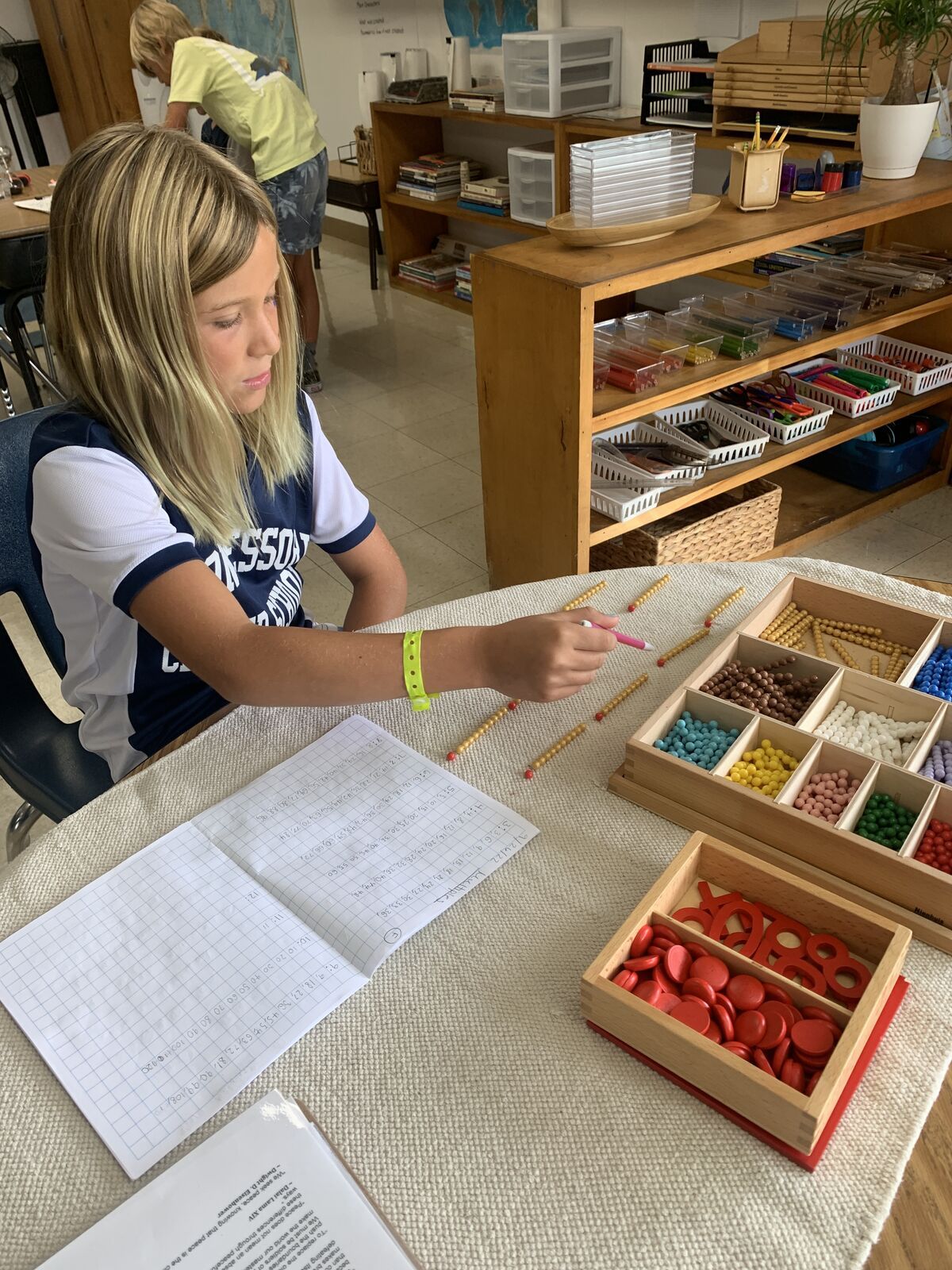A Snapshot of the Elementary Classroom

In a Montessori elementary classroom, there is a hum of activity and collaboration. Learn more from this engaged community of learners.
Nothing can substitute the beauty and spontaneity of classroom observation. But if you have ever wondered what it is like to sit in a Montessori elementary classroom, here are some of the areas, work, and interactions you might see!
Group Lesson
If you have been a Montessori parent of younger children, you will often see the guide, or teacher, giving a one-on-one lesson to a child. In elementary, lessons are given in small groups. This is because Dr. Montessori recognized that the social needs of the child change at this stage of life, and much of the work in elementary is done collaboratively.
You may even have trouble spotting the teacher because unlike in a traditional classroom, she/he is not standing up at the head of the class. The teacher is sitting with a group of students at a table or on the ground. Once the children understand the concept and have reached a level of self-sufficiency, the teacher will often leave and move on to another lesson while the children continue working independently.
Biology
You might see a group of children working with a hands-on classification material for plants called Kingdom Plantae or for animals called Kingdom Animalia. It introduces them to a taxonomy to categorize a species. There are branches that narrow as the child gets closer to identifying a particular species, beginning with the kingdom, then phylum, class, family, genus, and, finally, species. The material is intentionally incomplete to encourage the child to explore and fill in the material with their own examples.
History
You may see a couple of children roll out a timeline — perhaps the Timeline of Life — that is longer than your dining room table! There are different versions of this timeline, but as the children become more familiar, they might try the blank timeline. This one requires them to fill in the different eras with the associated plant and wildlife that came into existence over the history of the earth. The children learn about, for example, the explosion of plant life during the Devonian and the evolution of animals that led to the first mammals.
Geography
Remember the beloved puzzle maps from the Primary level? In elementary, geography gets far more sophisticated. You might see children working with a chart of ocean currents. After a series of demonstrations and experiments about the relationship between warm and cool air, the child will explore its impact on the oceans and learn about the different kinds of currents and their names.
Math
Most elementary children adore the cubing material. This beautiful, colorful material allows children to build physical representations of exponential growth and to do cubing work. The child can visually discern the difference between the size of 3-squared and 3-cubed. It is not uncommon for a group of children who are working with larger exponents to excitedly ask to borrow another box of cubing material so they can build the next larger exponent.
Language
Sentence diagramming takes on new life with the sentence analysis materials. Children write sentences on long strips of adding machine paper, dissect them into words and phrases with scissors, and use wooden arrows to guide them through questions that will determine their function in the sentence. Looking for the subject? Ask, “Who is it that? What is it that?”
Geometry
So many people learn the Pythagorean Theorem as a memorized formula in middle or high school. In a Montessori elementary classroom, you are likely to see children huddled around the Pythagorean plates. Many children extend the work by seeing if it works for other figures! Is it only squares that are built on the hypotenuse and sides that make this possible? What about hexagons?
Gardening
Our classroom communities are fortunate enough to have a gardening space that children manage. You may spot a group of children grabbing their gloves to weed or harvest some vegetables and herbs.
Science Experiments
Our STEAM Lab is an exciting space for our elementary students to build their knowledge of different scientific concepts using sensory experiences. In the lab our students exercise their problem-solving, critical thinking, team-building, creativiy and collaboration skills.
Specialists Instruction
Each week elementary students take classes in Art, Spanish, Computer Technology, Music, PE, and Drama, and have time to read and explore over 7,000 books in our Library.
To learn more about our elementary community of confident, engaged learners,
contact our Admissions Director to schedule a classroom visit.
Text: Guidepost Montessori
Programs
Montessori Center School admits students of any race, color, religion, national and ethnic origin, gender identity, and sexual orientation to all rights, privileges, programs and activities general recorded or made available to students at the School. It does not discriminate on the basis of race, color, religion, national and ethnic origin, gender identity or sexual orientation in the administration of its educational programs, admission and tuition assistance policies, and athletic or other school-administered programs. Non-Profit Education Organization, License No. 426205239


